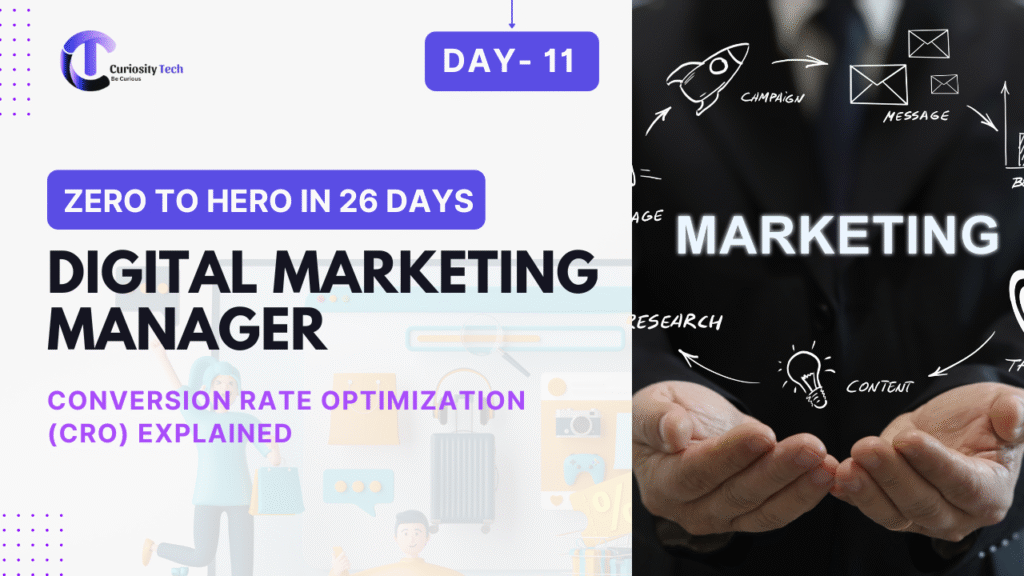Introduction
Traffic without conversions is like filling a leaky bucket. Businesses spend heavily on SEO, ads, and social campaigns, but if their websites don’t convert visitors into leads or sales, ROI collapses. That’s where Conversion Rate Optimization (CRO) comes in.
At CuriosityTech.in (Nagpur’s digital marketing and analytics hub), we’ve optimized landing pages and funnels for both startups and enterprises, achieving conversion lifts of 30–70% without increasing ad budgets.
What is Conversion Rate Optimization?
Conversion Rate (CR) = (Number of Conversions ÷ Total Visitors) × 100
Example:
- Visitors = 10,000/month
- Conversions (sales, form fills) = 500
- CR = (500 ÷ 10,000) × 100 = 5%
CRO is the structured process of increasing this percentage by improving design, messaging, speed, trust elements, and calls-to-action.
Scientific Approach to CRO
1. Hypothesis Formation (Research Stage)
- Identify bottlenecks: high bounce rates, cart abandonment, low form submissions.
- Form hypothesis: “Changing CTA button color from blue to orange will improve click-throughs.”
2. Experimentation (A/B or Multivariate Testing)
- A/B Test: Two variations → compare.
- Multivariate Test: Multiple elements at once.
📍 Example: At CuriosityTech, we tested headline variations on a client’s landing page. Result? Version B with “Get Started in 2 Minutes” increased sign-ups by 28%.
3. Measurement & Statistical Significance
- Use tools like Google Optimize, Optimizely, Hotjar.
- Check heatmaps (where users click/scroll).
- Ensure minimum sample size for valid results.
4. Implementation
- Deploy winning variations permanently.
- Document results for future learning.
Infographic Description: CRO Process Cycle
- Stage 1: Research → Analytics, heatmaps
- Stage 2: Hypothesis → Testable ideas
- Stage 3: Experiment → A/B testing
- Stage 4: Measure → Conversion uplift
- Stage 5: Implement → Scale changes
- Stage 6: Repeat → Continuous optimization
Key CRO Elements
| CRO Element | Example Optimization | Impact |
| Call-to-Action (CTA) | From “Submit” → “Get My Free Guide” | +20–40% clicks |
| Page Speed | 5s → 2s load time | -30% bounce rate |
| Trust Signals | Customer reviews, security badges | Boosts credibility |
| Forms | Reduce fields from 7 → 3 | Higher completion |
| Visual Hierarchy | Clear headings, contrasting CTAs | Better navigation |
Becoming a CRO Expert
- Data Literacy: Master GA4, heatmaps, user recordings.
- Design Psychology: Colors, layout, eye movement.
- Experimentation Mindset: Test continuously.
- Analytics Integration: Combine with Ads + Email funnels.
At CuriosityTech, we train digital marketers in scientific CRO frameworks, ensuring that every rupee spent on ads generates measurable returns.
Conclusion
CRO is not a one-time tactic; it’s a continuous cycle of research, testing, and optimization. Businesses that embrace CRO see compounding improvements—higher sales, lower acquisition costs, and stronger customer loyalty.
📍 Whether you run a Shopify store or a SaaS startup, CuriosityTech.in (Wardha Rd, Gajanan Nagar, Nagpur) can help implement data-driven CRO strategies that turn visitors into customers.


